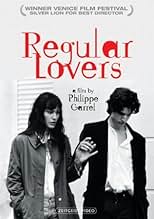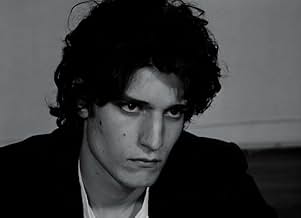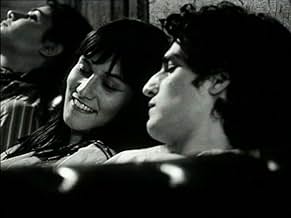IMDb-BEWERTUNG
6,8/10
3078
IHRE BEWERTUNG
Füge eine Handlung in deiner Sprache hinzuAmidst the chaos of student and union protests, 20-year-old Parisian poet François finds himself in legal hot water for dodging a stint in the French military. While at a party, he falls in ... Alles lesenAmidst the chaos of student and union protests, 20-year-old Parisian poet François finds himself in legal hot water for dodging a stint in the French military. While at a party, he falls in love with Lilie, a would-be sculptor.Amidst the chaos of student and union protests, 20-year-old Parisian poet François finds himself in legal hot water for dodging a stint in the French military. While at a party, he falls in love with Lilie, a would-be sculptor.
- Regie
- Drehbuch
- Hauptbesetzung
- Auszeichnungen
- 7 Gewinne & 5 Nominierungen insgesamt
Empfohlene Bewertungen
Seeing Les Amants Reguliers calls immediately for comparison with Bertolucci's movie 'The Dreamers', in my opinion the best film made about the 1968 revolt of students in Paris. Actually director Philippe Garrel does not seem to avoid comparing with his much more famous colleague, sharing the principal actor and even including a direct replica eye-in-viewer-eye about an older film of Bertolucci. And yet, LAR is a different film, and an interesting one.
The story line seems also familiar. The movie starts with long scenes of the 1968 'emeutes', maybe among the best done until now. The film is made in black-and-white, and the perspective of the static camera on one side or the other of the barricade reminds Eisenstein. Then, as in The Dreamers, the action moves in the Parisian flat where the heroes of the defeated revolt make art, smoke drugs, dream, and fall for one other. There is no direct social comment, no real explanation of the background of the revolt. The movie focuses on the psychology of the characters and on the love story between the main characters. It's like a premonition of the process of transition to the establishment that the generation of the 1968 went through, it's just that not all the participants may adapt or survive.
The film is more about the characters than about the events. And it is merely for the style it will be remembered about. The black-and-white cinema is memorable not only in the revolution scenes, but also when looking at the characters evolution. Many sequences are enhanced by a technique that is derived from the silent films movies, with long takes accompanied by a off piano tune. The effect is exquisite. Yet the length of the film is hardly justified, it lasts more than three hours and I doubt that cutting it to only two hours would have been a miss - actually I am convinced it's quite a contrary.
Without raising at the depth and subtlety of Bertolucci's movie LAR is another perspective to remember about one of the more important years in the history of France and of the world in the 20th century.
The story line seems also familiar. The movie starts with long scenes of the 1968 'emeutes', maybe among the best done until now. The film is made in black-and-white, and the perspective of the static camera on one side or the other of the barricade reminds Eisenstein. Then, as in The Dreamers, the action moves in the Parisian flat where the heroes of the defeated revolt make art, smoke drugs, dream, and fall for one other. There is no direct social comment, no real explanation of the background of the revolt. The movie focuses on the psychology of the characters and on the love story between the main characters. It's like a premonition of the process of transition to the establishment that the generation of the 1968 went through, it's just that not all the participants may adapt or survive.
The film is more about the characters than about the events. And it is merely for the style it will be remembered about. The black-and-white cinema is memorable not only in the revolution scenes, but also when looking at the characters evolution. Many sequences are enhanced by a technique that is derived from the silent films movies, with long takes accompanied by a off piano tune. The effect is exquisite. Yet the length of the film is hardly justified, it lasts more than three hours and I doubt that cutting it to only two hours would have been a miss - actually I am convinced it's quite a contrary.
Without raising at the depth and subtlety of Bertolucci's movie LAR is another perspective to remember about one of the more important years in the history of France and of the world in the 20th century.
The reason I am reviewing this is that the previous review, was written by someone who walked out of this film, not even half way through. Unfortunately for him, he missed out on a film of tremendous beauty. Agreed the film was very slow to start, in fact the friend I was with fell asleep briefly,I woke him before his snoring disturbed the rest of the audience. Thankfully the film developed from there into a story of love, drugs and what it was like to be young and free in the experimental 60s. Fantastic performances from the two leads and a great look to the film that gave it a real authentic feel. Be patient, like many great films its well worth the wait, and is certainly a film that I will look forward to revisiting! 8/10
Philippe Garrel makes us breathe the forgotten atmosphere of the Nouvelle Vague, almost lost among the vestiges of its ancient splendor but ready to rise again from its ashes if recalled from the past. They who are a little acquainted with the director's subjects, on the other hand, may know very well how he's obsessed by a lingering sense of loss as far as fickleness of reality is concerned. "Les amants réguliers", therefore, show us the parallel stories of an "amour fou" and of a tempted revolution gone to ruin under the direction of young French students.
The first part of the story is about the dramatic events of May '68 in France evoked in a series of astonishing plan-sequences, a sort of cinema verité style, that place the student insurrection in anything but an enviable light against a pitch-black background.
There's much that can be said about the peculiarities of black-and-white photography used to describe the battle between students and police, where the high contrasts confer an unrealistic atmosphere to the sequences and darkness closes in upon the excited bodies wrapping them in mystery. The images, completely deprived of words, show the real consistence of the myth, made of crude violence, more and more emphasized by the exasperated reality of the movie shootings. The individual doesn't count anything at all here: he tends to disappear in the mass. What really matters in these fight scenes are the significance of the mass-suggestion, the blind fury of the juvenile assault, sinister eulogies of the power of the mob, even if conceived like separate entities apart from any kind of emotion, with the cold and distant look of an entomologist intent to catalog his insect collection.
The second part of the story is described in a quieter and most intimate way. Stands out on the horizon the distressing portrait of a self-centered generation in search of its lost time, completely disenchanted about the individual values of men, inclined to rotate on its own axis between opium fumes and making a funeral oration in the praise of its recent defeat.
"Les amants réguliers" seems to evoke from time to time the shadow of the great Robert Bresson, revised and corrected by Garrel's particular sensibility without drifting away from the main argument, trying to expand overall perspectives on the subject of human disillusions that though painful may bring us to the truth. In my opinion, trying to penetrate deeply into the substrate of the story, if a man lets himself go and play things by ear, he probably will find that he can bring out the dark side of his self with dire and irretrievable consequences.
The first part of the story is about the dramatic events of May '68 in France evoked in a series of astonishing plan-sequences, a sort of cinema verité style, that place the student insurrection in anything but an enviable light against a pitch-black background.
There's much that can be said about the peculiarities of black-and-white photography used to describe the battle between students and police, where the high contrasts confer an unrealistic atmosphere to the sequences and darkness closes in upon the excited bodies wrapping them in mystery. The images, completely deprived of words, show the real consistence of the myth, made of crude violence, more and more emphasized by the exasperated reality of the movie shootings. The individual doesn't count anything at all here: he tends to disappear in the mass. What really matters in these fight scenes are the significance of the mass-suggestion, the blind fury of the juvenile assault, sinister eulogies of the power of the mob, even if conceived like separate entities apart from any kind of emotion, with the cold and distant look of an entomologist intent to catalog his insect collection.
The second part of the story is described in a quieter and most intimate way. Stands out on the horizon the distressing portrait of a self-centered generation in search of its lost time, completely disenchanted about the individual values of men, inclined to rotate on its own axis between opium fumes and making a funeral oration in the praise of its recent defeat.
"Les amants réguliers" seems to evoke from time to time the shadow of the great Robert Bresson, revised and corrected by Garrel's particular sensibility without drifting away from the main argument, trying to expand overall perspectives on the subject of human disillusions that though painful may bring us to the truth. In my opinion, trying to penetrate deeply into the substrate of the story, if a man lets himself go and play things by ear, he probably will find that he can bring out the dark side of his self with dire and irretrievable consequences.
This is clearly a French film. It is about young group of idealist/revolutionary/anarchistic people. It moves very slowly. Long takes. LOng closeups. A minute or more devoted to an attempt to light a pipe full of hash/opium. A long take on how a group overturns a car and burns it. It is a black and white film. The subtitles were white, so about a third of the time they were unreadable. (Why do they do this?) I walked out after about an hour and three quarters when it became clear that this picture was going nowhere, slow. I was not the first to walk out. It was the first time I walked out of a picture in my long lifetime. (Well, maybe the second.)
This is one of many films I have seen at the Melbourne French Film Festival 2006. I average 100 films a year on the big screen and this is only the third film I have ever walked out on (after 75 minutes).
Yes, it looks absolutely beautiful. Cinematography and lighting are great. The characters all look authentic and you'd swear you were watching a film made 30 or more years ago. It looks like a piece of art, but for me cinema is all about telling a story. And that's where this film falls apart - all style and no substance.
There is no story, nothing compelling. It was so laborious to watch and a struggle to stay awake. There was little to differentiate this film from just looking at a book of old European photography (and that's not what I go to a cinema for, as much as I love photography). I felt that if it was like this after 75 minutes, how can I sit here for 3 hours! Obviously many others felt the same way because about 10% of the audience left before us. The only other time that I have seen a walkout like this was with The Aristocrats. This film was a wasted opportunity.
Yes, it looks absolutely beautiful. Cinematography and lighting are great. The characters all look authentic and you'd swear you were watching a film made 30 or more years ago. It looks like a piece of art, but for me cinema is all about telling a story. And that's where this film falls apart - all style and no substance.
There is no story, nothing compelling. It was so laborious to watch and a struggle to stay awake. There was little to differentiate this film from just looking at a book of old European photography (and that's not what I go to a cinema for, as much as I love photography). I felt that if it was like this after 75 minutes, how can I sit here for 3 hours! Obviously many others felt the same way because about 10% of the audience left before us. The only other time that I have seen a walkout like this was with The Aristocrats. This film was a wasted opportunity.
Wusstest du schon
- WissenswertesClémentine Poidatz's debut.
- PatzerA Volvo 66 is featured prominently during the riot scenes in the beginning of the film. The production of this model hadn't begun until 1975.
Top-Auswahl
Melde dich zum Bewerten an und greife auf die Watchlist für personalisierte Empfehlungen zu.
- How long is Regular Lovers?Powered by Alexa
Details
Box Office
- Weltweiter Bruttoertrag
- 125.381 $
- Laufzeit3 Stunden 3 Minuten
- Farbe
- Sound-Mix
- Seitenverhältnis
- 1.37 : 1
Zu dieser Seite beitragen
Bearbeitung vorschlagen oder fehlenden Inhalt hinzufügen
























